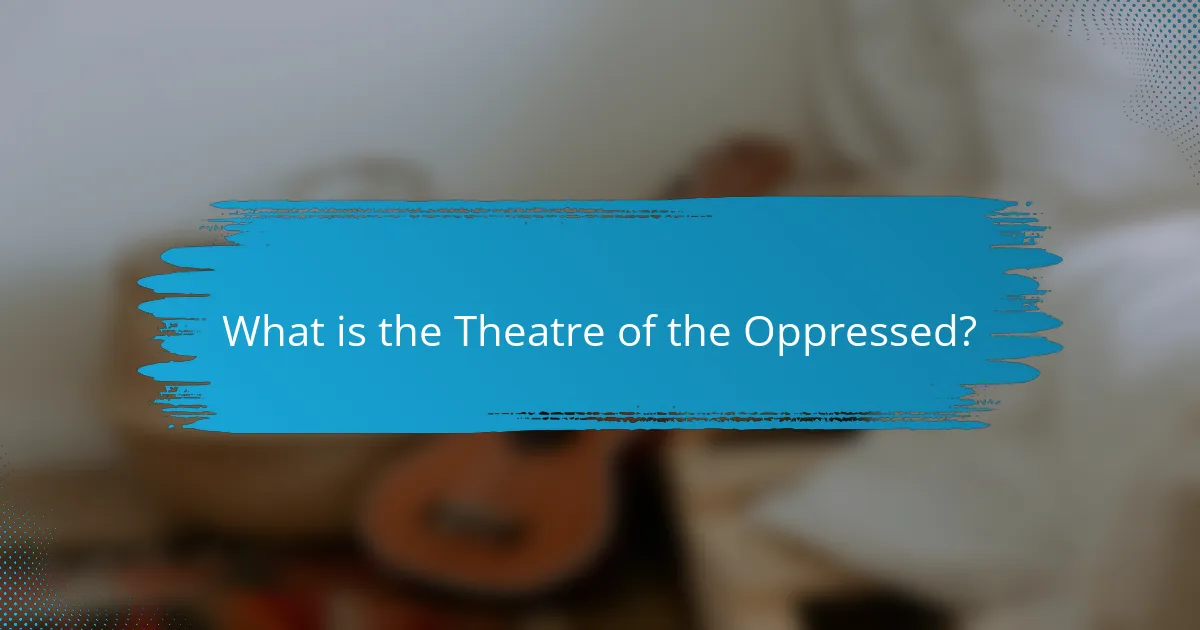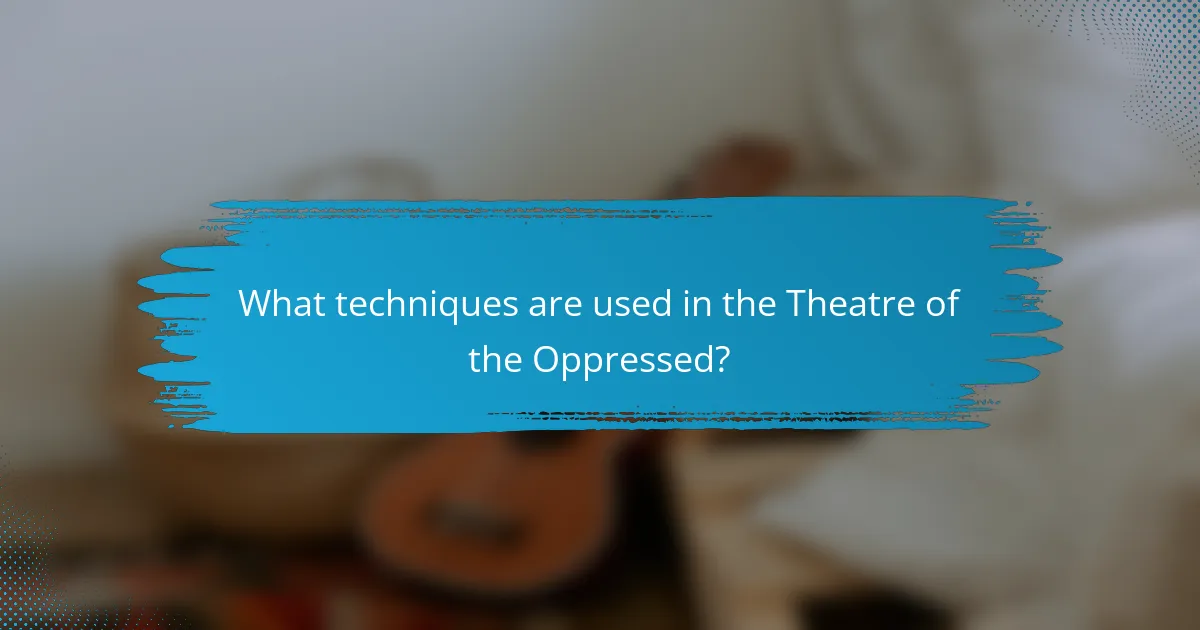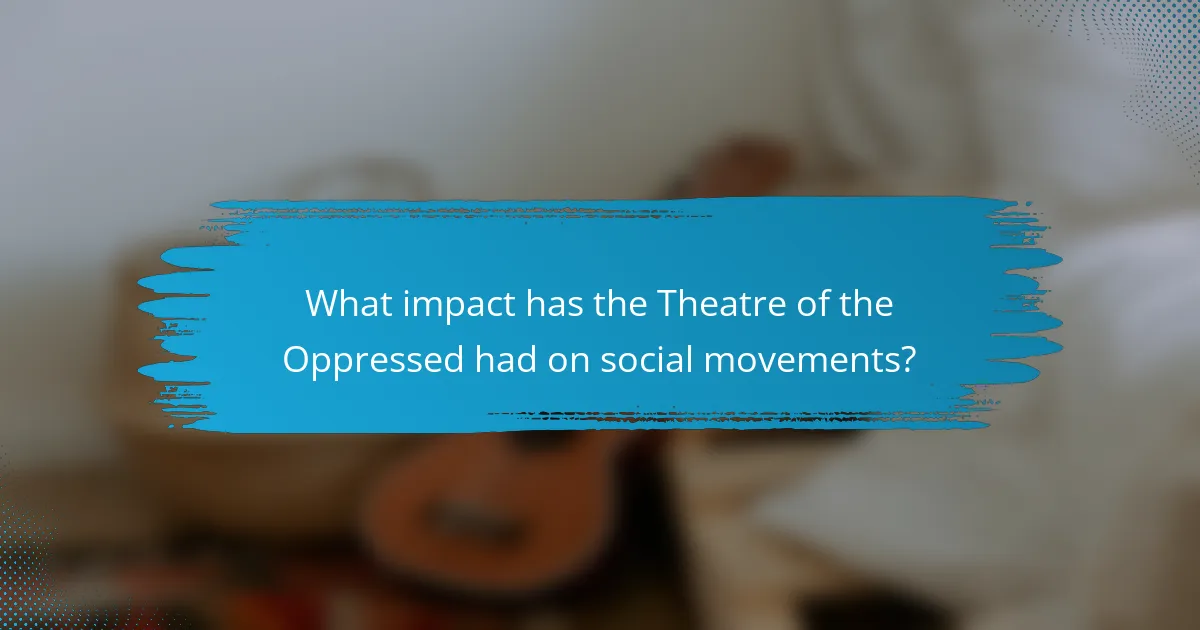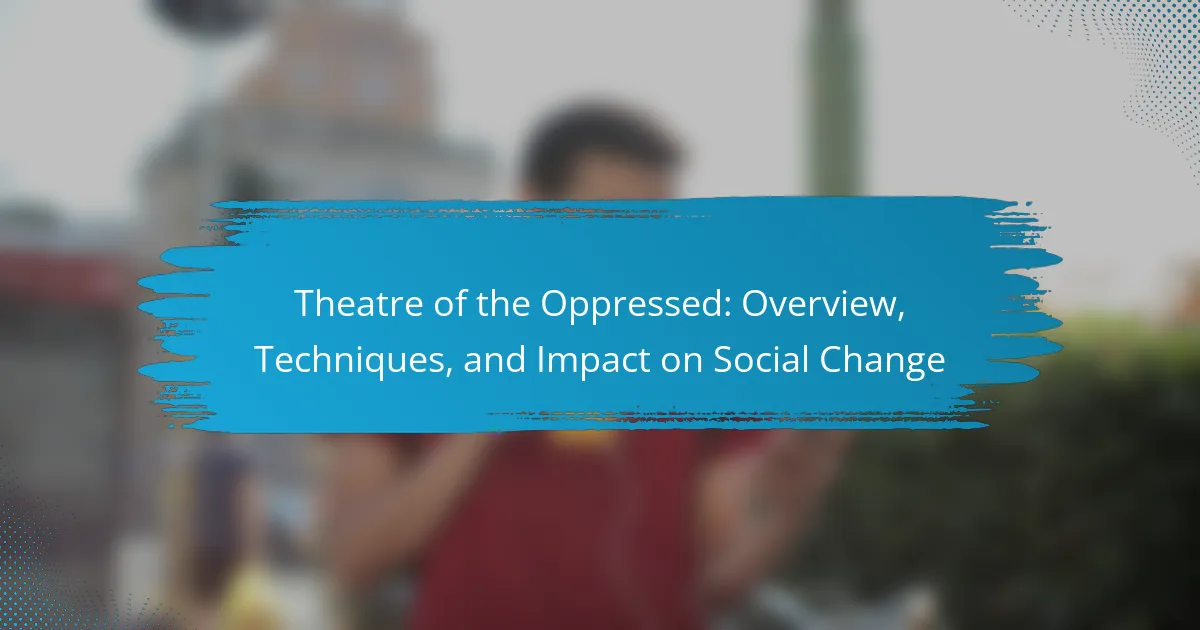The Theatre of the Oppressed is a theatrical methodology developed by Augusto Boal, designed to facilitate social and political change through interactive performances that engage audiences as active participants, referred to as “spect-actors.” This article provides an overview of the various techniques employed within this methodology, including Forum Theatre, Image Theatre, Invisible Theatre, Legislative Theatre, and Newspaper Theatre, each aimed at fostering dialogue and reflection on social issues. The Theatre of the Oppressed has played a significant role in empowering marginalized voices and has been instrumental in various social movements worldwide, enhancing community solidarity and mobilization against oppression and injustice. Key examples of its impact include its contributions to anti-apartheid movements in South Africa and community organizing efforts in Brazil.

What is the Theatre of the Oppressed?
The Theatre of the Oppressed is a theatrical methodology created by Augusto Boal. It aims to promote social and political change through interactive performances. This form of theatre encourages audience participation. It transforms spectators into “spect-actors.” This approach allows individuals to express their experiences and challenge societal norms. The methodology includes techniques like Forum Theatre and Image Theatre. These techniques foster dialogue and reflection on social issues. The Theatre of the Oppressed has been implemented worldwide to address oppression and injustice.
How did the Theatre of the Oppressed originate?
The Theatre of the Oppressed originated in Brazil in the 1960s. It was developed by Augusto Boal as a response to political repression. Boal aimed to empower marginalized communities through interactive theater. The method encourages participants to explore social issues and enact solutions. The approach was influenced by Paulo Freire’s pedagogy of the oppressed. It emphasizes dialogue and participation as tools for social change. The first major work was “Theatre of the Oppressed,” published in 1974. This work laid the foundation for the global movement that followed.
Who were the key figures in its development?
The key figures in the development of Theatre of the Oppressed include Augusto Boal, Paulo Freire, and various community activists. Augusto Boal founded the Theatre of the Oppressed in the 1970s. He aimed to use theatre as a means of social change and empowerment. Paulo Freire’s pedagogy influenced Boal’s methods, emphasizing dialogue and critical consciousness. Boal’s work involved collaboration with marginalized communities. Various activists contributed to the adaptation of Boal’s techniques in different cultural contexts. Their collective efforts helped popularize participatory theatre as a tool for social justice.
What historical contexts influenced its emergence?
The Theatre of the Oppressed emerged in the context of political and social upheaval in the 1960s. It was influenced by the civil rights movements and anti-colonial struggles worldwide. These movements sought to challenge oppressive systems and empower marginalized communities. Augusto Boal, its founder, developed the techniques in Brazil, responding to the military dictatorship in 1964. The need for social change and the desire for participatory art forms shaped its development. The methods aimed to give voice to the oppressed and encourage active engagement in societal issues. The historical context of repression and resistance provided a fertile ground for this innovative theatrical approach.
What are the core principles of the Theatre of the Oppressed?
The core principles of the Theatre of the Oppressed include dialogue, participation, and transformation. Dialogue emphasizes communication between performers and the audience. This fosters mutual understanding and collective reflection. Participation encourages active involvement of the audience in the theatrical process. This principle empowers individuals to express their experiences and perspectives. Transformation focuses on social change through the exploration of oppressive situations. It aims to inspire action and challenge societal norms. These principles are rooted in the work of Augusto Boal, who developed this theatrical approach to address issues of power and oppression.
How does it define oppression?
Oppression is defined as the systematic and pervasive exercise of power that limits the freedom and potential of individuals or groups. It manifests through social, political, and economic inequalities. This definition emphasizes that oppression is not merely an individual act, but a structural phenomenon. It often involves the marginalization of certain groups based on attributes such as race, gender, or class. Historical contexts, such as colonialism and slavery, illustrate how oppression has been institutionalized. The Theatre of the Oppressed aims to raise awareness of these dynamics. It encourages dialogue and reflection on the lived experiences of the oppressed. This engagement helps to empower individuals to challenge and transform oppressive systems.
What role does audience participation play?
Audience participation plays a crucial role in the Theatre of the Oppressed. It transforms passive viewers into active participants. This engagement fosters a sense of ownership over the performance. Participants can share their experiences and perspectives. This interaction helps highlight social issues and injustices. It also encourages dialogue and collective problem-solving. Research shows that active participation can lead to greater empathy and understanding among participants. By involving the audience, the Theatre of the Oppressed aims to empower individuals to enact social change.

What techniques are used in the Theatre of the Oppressed?
Theatre of the Oppressed employs several techniques to engage participants and promote social change. These techniques include Forum Theatre, where audience members can intervene in a performance to suggest solutions. Another technique is Image Theatre, which uses still images to express feelings and ideas. Additionally, Invisible Theatre involves actors performing in public spaces without the audience’s awareness. Other methods include Legislative Theatre, which aims to create laws through performance, and Newspaper Theatre, which adapts news articles into theatrical pieces. Each technique serves to empower participants and stimulate dialogue about oppression and social justice.
What are the main forms of theatre utilized?
The main forms of theatre utilized include forum theatre, image theatre, and legislative theatre. Forum theatre allows audiences to intervene and change the outcome of a performance. This form encourages dialogue and participation, fostering critical engagement with social issues. Image theatre uses tableaux to express feelings and situations without words. It empowers participants to visualize and discuss their experiences. Legislative theatre involves creating plays that propose solutions to social problems. This form aims to influence policymakers and engage communities in dialogue about potential changes. Each of these forms serves as a tool for social change and empowerment.
How does Forum Theatre function?
Forum Theatre functions as an interactive form of theatre aimed at social change. It involves a performance that presents a problem or conflict faced by a community. After the initial performance, audience members, referred to as “spect-actors,” can interrupt and suggest changes to the action. This process allows participants to explore solutions to the issues presented. The director, known as the “joker,” facilitates discussions and encourages dialogue among participants. This method empowers individuals to express their thoughts and experiences. Forum Theatre has been used globally to address various social issues, demonstrating its effectiveness in community engagement and awareness.
What is the purpose of Image Theatre?
The purpose of Image Theatre is to explore and communicate social issues through visual imagery. It allows participants to create and manipulate images that represent their experiences and perceptions. This technique encourages dialogue and reflection among participants. Image Theatre aims to raise awareness and provoke thought about societal injustices. It is a method used in the Theatre of the Oppressed framework. Augusto Boal developed this technique to empower marginalized voices. Participants engage in a collaborative process to express their realities visually. This approach fosters critical thinking and collective problem-solving.
How do these techniques promote social change?
Theatre of the Oppressed techniques promote social change by empowering marginalized voices. These techniques encourage active participation and dialogue among community members. They create a platform for individuals to express their experiences and challenges. This process fosters awareness of social injustices and collective reflection. For instance, the use of forum theatre allows audiences to intervene in performances. This interaction can lead to discussions about potential solutions to social issues. Historical examples show that these techniques have led to community mobilization and policy changes. In Brazil, Augusto Boal’s methods have inspired grassroots movements that address local inequalities.
What methods are employed to engage the audience?
Theatre of the Oppressed employs interactive techniques to engage the audience. These methods include Forum Theatre, where spectators become “spect-actors” and participate in the performance. This approach encourages dialogue and critical thinking about social issues. Another method is Image Theatre, where participants create still images to represent feelings or situations. This visual representation fosters discussion and reflection. Additionally, the use of role-playing allows audience members to explore different perspectives. These techniques aim to empower participants and stimulate social change. Research shows that audience engagement increases awareness and motivates action in social justice contexts.
How does the process of re-enactment contribute to awareness?
The process of re-enactment contributes to awareness by allowing participants to engage with historical events or social issues in a tangible way. This engagement fosters empathy and understanding among participants and audiences. Re-enactment serves as a tool for education, highlighting the experiences of marginalized groups. It encourages critical reflection on societal norms and injustices. Research shows that participatory methods, including re-enactment, enhance retention of information and emotional connection to the subject matter. This method has been effectively used in the Theatre of the Oppressed to stimulate dialogue and raise consciousness about social issues.

What impact has the Theatre of the Oppressed had on social movements?
The Theatre of the Oppressed has significantly influenced social movements by providing a platform for marginalized voices. It empowers individuals to express their struggles and challenge oppression through interactive performance. This method encourages active participation, fostering dialogue and critical thinking among audiences. Notable examples include its role in anti-apartheid movements in South Africa and community organizing in Brazil. The techniques of Forum Theatre and Image Theatre allow participants to rehearse solutions to social issues. Research indicates that these practices enhance community solidarity and mobilization. The Theatre of the Oppressed has been instrumental in raising awareness and inspiring action against injustice.
How has it been used in various cultural contexts?
Theatre of the Oppressed has been used in various cultural contexts to address social injustices. It originated in Brazil in the 1970s, developed by Augusto Boal. The technique allows marginalized communities to express their experiences and challenge oppression. In many countries, it has been adapted to local issues, such as racism, poverty, and gender inequality. For example, in India, it has been used to empower women and address caste discrimination. In South Africa, it has facilitated dialogues about apartheid and its aftermath. The method encourages audience participation, transforming spectators into “spect-actors.” This participatory approach fosters critical thinking and community engagement. Overall, Theatre of the Oppressed serves as a powerful tool for social change in diverse cultural settings.
What examples exist of successful social change initiatives?
Theatre of the Oppressed is a successful social change initiative. It was developed by Augusto Boal in the 1970s. This approach uses theatrical techniques to promote dialogue and empower marginalized communities. One notable example is the “Invisible Theatre” technique. This involves performances in public spaces without the audience’s prior knowledge. It sparks conversations about social issues in real-time.
Another example is the “Forum Theatre” method. In this format, actors present a scene depicting oppression. Audience members can intervene and suggest alternative actions. This interactive approach encourages participants to explore solutions collaboratively.
Theatre of the Oppressed has been implemented globally. It has addressed issues like poverty, racism, and gender inequality. In Brazil, it helped communities confront police violence. In South Africa, it supported anti-apartheid movements. These initiatives demonstrate the effectiveness of theatre as a tool for social change.
How does it empower marginalized communities?
Theatre of the Oppressed empowers marginalized communities by providing a platform for expression and dialogue. It encourages participants to explore their social issues through performance. This method fosters critical thinking and collective problem-solving. Participants gain confidence by sharing their stories in a supportive environment. The process promotes awareness of systemic injustices. It also cultivates solidarity among community members. Research shows that such engagement can lead to social change. For example, Augusto Boal, the creator of Theatre of the Oppressed, emphasized its role in transforming spectators into active participants.
What challenges does the Theatre of the Oppressed face today?
The Theatre of the Oppressed faces several challenges today. One major challenge is the lack of funding and resources. Many groups struggle to secure financial support for their projects. This limits their ability to reach wider audiences and sustain their initiatives. Another challenge is the increasing commercialization of art and performance. This trend often overshadows community-focused, socially conscious work. Additionally, there is a growing need for adaptation to digital platforms. Many practitioners must transition their work to online formats due to global events like the COVID-19 pandemic. This shift can dilute the interactive nature of theatre. Furthermore, there are challenges related to audience engagement. Capturing the attention of diverse communities requires innovative approaches. Lastly, political repression in various regions poses threats to free expression. This can hinder the ability to address social issues openly.
What criticisms have been directed at its effectiveness?
Criticisms of the Theatre of the Oppressed’s effectiveness include doubts about its ability to produce lasting social change. Some critics argue that the techniques may only create temporary awareness without leading to actionable outcomes. Others suggest that the focus on performance can overshadow the need for concrete political action. Additionally, there are claims that the approach may not adequately address the complexities of systemic oppression. Critics point to limited empirical evidence demonstrating measurable impact on communities. Furthermore, some argue that the participatory nature might not engage all audience members equally. These concerns highlight the ongoing debate about the methodology’s practical implications in real-world contexts.
How can practitioners overcome these obstacles?
Practitioners can overcome obstacles in the Theatre of the Oppressed by employing specific strategies. They can enhance community engagement through active participation. This involvement fosters trust and collaboration among participants. Practitioners can also utilize training workshops to build skills and confidence. Workshops provide tools for effective expression and communication. Additionally, adapting techniques to local contexts increases relevance and impact. This ensures that the performances resonate with community experiences. Lastly, practitioners can seek partnerships with local organizations for support and resources. Collaboration amplifies reach and effectiveness in addressing social issues.
What best practices should be followed when implementing Theatre of the Oppressed?
Engage participants actively in the process. This fosters a sense of ownership and empowerment. Use a facilitator skilled in Theatre of the Oppressed techniques. Their expertise ensures effective communication and guidance. Create a safe space for expression. This encourages honest dialogue and vulnerability. Incorporate diverse perspectives in the group. This enriches the experience and promotes inclusivity. Focus on real-life issues relevant to participants. This enhances relatability and impact. Practice improvisation and spontaneity during sessions. This allows for creativity and adaptability. Evaluate and reflect on each session. This helps in understanding outcomes and improving future practices.
Theatre of the Oppressed is a theatrical methodology developed by Augusto Boal, designed to promote social and political change through interactive performances that engage the audience as “spect-actors.” Originating in Brazil during the 1960s, it incorporates techniques such as Forum Theatre and Image Theatre to foster dialogue and reflection on social issues. The article explores its historical context, core principles, and the roles of key figures like Paulo Freire, while also examining the impact of these techniques on social movements globally. Additionally, it addresses challenges faced by practitioners today and offers best practices for effective implementation.
